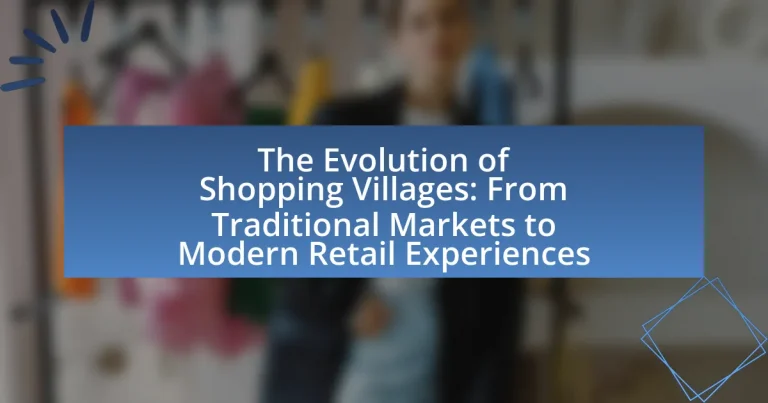Shopping villages are retail complexes that blend shopping, leisure, and dining experiences, designed to evoke traditional village settings. Emerging in response to suburban shopping centers in the late 20th century, these villages have revitalized local economies by attracting tourists and preserving cultural heritage. The article explores the evolution of shopping villages from traditional markets, highlighting the influence of trade routes, cultural factors, and economic practices. It examines the role of shopping villages in supporting local artisans, enhancing community interactions, and adapting to modern consumer preferences, while also addressing challenges such as competition from online retail and economic fluctuations. Key features of modern shopping villages, including sustainability practices and experiential retail trends, are discussed, along with strategies for fostering community engagement and loyalty.

What are Shopping Villages and Their Historical Significance?
Shopping villages are retail complexes that combine shopping with leisure and dining experiences, often designed to resemble traditional village settings. Historically, they emerged as a response to the rise of suburban shopping centers in the late 20th century, aiming to create a more inviting and community-oriented shopping environment. The concept gained popularity in the 1980s and 1990s, particularly in Europe and North America, where they were often built around historical architecture or themes to enhance the shopping experience. Shopping villages have played a significant role in revitalizing local economies by attracting tourists and providing a unique shopping alternative to conventional malls, thus contributing to the preservation of cultural heritage and community identity.
How did traditional markets evolve into shopping villages?
Traditional markets evolved into shopping villages through a combination of urbanization, consumer demand for diverse shopping experiences, and the integration of community spaces. As cities expanded, traditional markets adapted by incorporating modern amenities and a wider range of retail options, leading to the creation of shopping villages that offer both shopping and social interaction. Historical trends indicate that the rise of consumer culture in the late 20th century prompted the transformation of these markets into more organized, themed environments, often featuring a mix of local artisans and larger retail brands, thereby enhancing the shopping experience while maintaining a sense of community.
What cultural factors influenced the development of traditional markets?
Cultural factors such as community interaction, local customs, and economic practices significantly influenced the development of traditional markets. Community interaction fostered social bonds, making markets not just places for commerce but also social hubs where people gathered, exchanged news, and maintained relationships. Local customs dictated the types of goods sold, often reflecting regional agricultural practices and cultural preferences, which shaped market offerings. Economic practices, including barter systems and localized trade, established the foundational economic structures of these markets, allowing them to thrive based on mutual trust and shared cultural values. Historical evidence shows that in many societies, traditional markets evolved alongside cultural festivals and rituals, further embedding them into the social fabric of communities.
How did trade routes contribute to the emergence of shopping villages?
Trade routes significantly contributed to the emergence of shopping villages by facilitating the exchange of goods and ideas, which led to the establishment of centralized marketplaces. As merchants traveled along these routes, they brought diverse products and cultural influences, creating a demand for permanent trading posts. Historical evidence shows that locations along major trade routes, such as the Silk Road, evolved into bustling centers where local artisans and traders could sell their goods, thus forming the foundation for shopping villages. These villages became hubs of commerce, attracting consumers and fostering community interactions, which further solidified their role in the retail landscape.
What role did shopping villages play in local economies?
Shopping villages significantly contributed to local economies by serving as hubs for commerce, tourism, and community engagement. These retail spaces attracted both local residents and visitors, fostering economic activity through increased foot traffic and sales. For instance, shopping villages often feature a mix of independent retailers and dining options, which can enhance local employment opportunities and stimulate surrounding businesses. According to a study by the International Council of Shopping Centers, shopping centers, including villages, generate substantial tax revenue for local governments, further underscoring their economic impact.
How did shopping villages support local artisans and businesses?
Shopping villages supported local artisans and businesses by providing a dedicated space for them to showcase and sell their products directly to consumers. This model facilitated increased visibility and foot traffic, allowing artisans to reach a broader audience than they might have in isolated settings. Additionally, shopping villages often fostered a sense of community, encouraging collaboration among local businesses and creating a unique shopping experience that highlighted local craftsmanship. For instance, studies have shown that shopping villages can increase local economic activity by up to 30%, demonstrating their significant impact on supporting local economies and artisans.
What impact did shopping villages have on community interactions?
Shopping villages significantly enhanced community interactions by providing a centralized space for social engagement and local commerce. These environments fostered a sense of belonging and community identity, as they often host events, markets, and gatherings that encourage residents to connect. Research indicates that shopping villages contribute to increased foot traffic and social cohesion, as seen in studies highlighting that such spaces can lead to a 20% increase in local community events and interactions. This integration of shopping and social spaces has transformed how communities engage, making shopping villages vital hubs for local culture and interaction.

What are the Key Features of Modern Shopping Villages?
Modern shopping villages are characterized by a blend of retail, dining, and entertainment options designed to create a community-centric experience. These shopping destinations typically feature open-air layouts, pedestrian-friendly pathways, and a mix of local boutiques and well-known brands, fostering a vibrant atmosphere. Additionally, modern shopping villages often incorporate green spaces, art installations, and community events, enhancing the social experience for visitors. The integration of technology, such as mobile apps for navigation and promotions, further enriches the shopping experience, making it more interactive and convenient.
How do modern shopping villages differ from traditional markets?
Modern shopping villages differ from traditional markets primarily in their design, structure, and shopping experience. Shopping villages are typically purpose-built environments that offer a curated selection of retail stores, dining options, and entertainment facilities, often set in aesthetically pleasing landscapes, while traditional markets are usually informal, open-air venues where local vendors sell goods directly to consumers.
For instance, shopping villages often feature brand-name retailers and a controlled shopping atmosphere, which contrasts with the diverse, often unregulated offerings of traditional markets that focus on local produce and handmade goods. Additionally, shopping villages may incorporate modern amenities such as parking, climate control, and organized layouts, enhancing the consumer experience compared to the more chaotic and spontaneous nature of traditional markets.
What amenities and services are commonly found in modern shopping villages?
Modern shopping villages typically feature a variety of amenities and services designed to enhance the shopping experience. Common offerings include retail stores, dining options such as restaurants and cafes, entertainment facilities like cinemas or play areas, and essential services such as parking, restrooms, and free Wi-Fi. Additionally, many shopping villages incorporate green spaces, community events, and accessibility features to cater to diverse customer needs. These elements collectively create a vibrant environment that encourages longer visits and increased consumer engagement.
How has technology influenced the design of shopping villages?
Technology has significantly influenced the design of shopping villages by integrating digital experiences and enhancing customer engagement. For instance, the incorporation of augmented reality (AR) allows shoppers to visualize products in real-time, while mobile apps facilitate personalized shopping experiences through tailored promotions and navigation assistance. Furthermore, data analytics enable retailers to understand consumer behavior, leading to optimized layouts and targeted marketing strategies. According to a report by the International Council of Shopping Centers, 70% of consumers prefer shopping environments that incorporate technology, highlighting its impact on design choices in modern shopping villages.
What trends are shaping the future of shopping villages?
The future of shopping villages is being shaped by trends such as experiential retail, sustainability, and digital integration. Experiential retail focuses on creating immersive shopping experiences that engage customers beyond traditional purchasing, with 70% of consumers valuing experiences over products. Sustainability is increasingly important, with 81% of consumers feeling strongly that companies should help improve the environment, prompting shopping villages to adopt eco-friendly practices. Digital integration, including the use of mobile apps and augmented reality, enhances customer engagement and convenience, as evidenced by the growing adoption of technology in retail spaces. These trends collectively redefine shopping villages, making them more appealing and relevant to modern consumers.
How are sustainability practices being integrated into shopping villages?
Sustainability practices are being integrated into shopping villages through the implementation of eco-friendly building designs, waste reduction initiatives, and the promotion of local products. Shopping villages are increasingly adopting green architecture, which includes energy-efficient systems and sustainable materials, to minimize their environmental impact. For instance, many shopping villages now feature solar panels and rainwater harvesting systems, which contribute to energy savings and resource conservation. Additionally, waste management programs are being established to reduce landfill contributions, with many villages encouraging recycling and composting among tenants and visitors. Furthermore, the emphasis on sourcing local products supports sustainable agriculture and reduces carbon footprints associated with transportation. These practices not only enhance the ecological footprint of shopping villages but also align with consumer preferences for environmentally responsible shopping experiences.
What role does experiential retail play in modern shopping villages?
Experiential retail plays a crucial role in modern shopping villages by enhancing customer engagement and creating memorable shopping experiences. This approach transforms traditional retail spaces into interactive environments where consumers can participate in activities, attend events, and enjoy unique services, thereby fostering a sense of community and connection. For instance, shopping villages often incorporate features like pop-up shops, workshops, and entertainment options, which not only attract foot traffic but also encourage longer visits and increased spending. Research indicates that 70% of consumers prefer experiences over products, highlighting the effectiveness of experiential retail in driving sales and customer loyalty in these modern retail settings.

What Challenges Do Shopping Villages Face Today?
Shopping villages today face significant challenges, including competition from online retail, changing consumer preferences, and economic fluctuations. The rise of e-commerce has led to a decline in foot traffic, as consumers increasingly opt for the convenience of online shopping. Additionally, shopping villages must adapt to evolving consumer expectations for unique experiences and sustainable practices, which can require substantial investment. Economic downturns can further impact sales and foot traffic, making it difficult for these retail spaces to maintain profitability. According to a report by the International Council of Shopping Centers, 70% of consumers prefer shopping in environments that offer a mix of retail, dining, and entertainment, highlighting the need for shopping villages to innovate and diversify their offerings to remain relevant.
How has online shopping impacted the viability of shopping villages?
Online shopping has significantly diminished the viability of shopping villages by redirecting consumer spending towards digital platforms. As e-commerce sales reached approximately $4.9 trillion globally in 2021, traditional shopping venues have struggled to compete with the convenience and variety offered online. This shift has led to decreased foot traffic in shopping villages, resulting in many retailers facing financial challenges and some even closing their physical locations. The rise of online shopping has fundamentally altered consumer behavior, prioritizing speed and accessibility, which further undermines the traditional shopping village model.
What strategies are shopping villages employing to compete with e-commerce?
Shopping villages are employing experiential retail strategies to compete with e-commerce. These strategies include creating immersive shopping experiences, hosting events, and offering unique local products that cannot be easily replicated online. For instance, many shopping villages have introduced interactive workshops, food tastings, and seasonal festivals to attract visitors and enhance customer engagement. Additionally, they focus on building a sense of community by featuring local artisans and promoting sustainable practices, which resonate with consumers seeking authenticity. This approach is supported by research indicating that 70% of consumers prefer experiences over products, highlighting the effectiveness of these strategies in drawing foot traffic away from online shopping platforms.
How are changing consumer preferences affecting shopping villages?
Changing consumer preferences are significantly affecting shopping villages by driving a shift towards experiential retail and sustainability. As consumers increasingly prioritize unique experiences over mere transactions, shopping villages are adapting by incorporating entertainment, dining, and community events to enhance the shopping experience. Additionally, the growing demand for sustainable and locally sourced products is prompting shopping villages to feature local artisans and eco-friendly brands, aligning with consumer values. For instance, a report by McKinsey & Company highlights that 67% of consumers consider sustainability when making purchase decisions, indicating a clear trend that shopping villages must respond to in order to remain relevant and attract foot traffic.
What are the economic challenges facing shopping villages?
Shopping villages face several economic challenges, including competition from online retail, changing consumer preferences, and rising operational costs. The shift towards e-commerce has significantly impacted foot traffic and sales in physical shopping locations, as consumers increasingly prefer the convenience of online shopping. Additionally, consumer preferences have evolved towards experiential shopping, which requires shopping villages to adapt their offerings to attract visitors. Rising operational costs, including rent and utilities, further strain the financial viability of these retail spaces, making it difficult for them to maintain profitability. These factors collectively threaten the sustainability and growth of shopping villages in the modern retail landscape.
How do economic downturns influence the success of shopping villages?
Economic downturns negatively influence the success of shopping villages by reducing consumer spending and altering shopping behaviors. During economic recessions, consumers tend to prioritize essential goods over discretionary purchases, leading to decreased foot traffic and sales in shopping villages. For instance, a study by the National Retail Federation indicated that during the 2008 financial crisis, retail sales dropped significantly, impacting various shopping venues, including shopping villages. Additionally, economic downturns often result in increased vacancy rates as retailers struggle to maintain profitability, further diminishing the attractiveness of shopping villages to potential customers.
What funding opportunities exist for revitalizing shopping villages?
Funding opportunities for revitalizing shopping villages include government grants, community development block grants, and private investment initiatives. Government grants, such as those from the Economic Development Administration, provide financial support for projects aimed at enhancing local economies. Community development block grants, administered by the U.S. Department of Housing and Urban Development, can be utilized for infrastructure improvements and business support in shopping villages. Additionally, private investment initiatives, including partnerships with local businesses and crowdfunding platforms, can mobilize community resources for revitalization efforts. These funding sources are critical for transforming shopping villages into vibrant retail experiences, as evidenced by successful revitalization projects across various regions that have leveraged such funding to stimulate economic growth and community engagement.
What Best Practices Can Enhance the Success of Shopping Villages?
To enhance the success of shopping villages, implementing a mix of strategic location selection, diverse tenant mix, and community engagement is essential. Strategic location selection ensures accessibility and visibility, attracting foot traffic; for instance, shopping villages situated near residential areas or major transportation hubs tend to perform better. A diverse tenant mix, including local artisans, popular brands, and unique dining options, creates a vibrant atmosphere that appeals to a broader audience, as evidenced by the success of shopping villages like The Grove in Los Angeles, which features a variety of shops and restaurants. Community engagement through events, promotions, and partnerships with local organizations fosters a sense of belonging and loyalty among shoppers, which can significantly boost repeat visits and overall sales.
How can shopping villages foster community engagement and loyalty?
Shopping villages can foster community engagement and loyalty by creating a sense of belonging through local events and unique shopping experiences. These villages often host community-oriented activities such as farmers’ markets, art fairs, and seasonal festivals, which encourage residents to participate and connect with one another. Research indicates that 70% of consumers prefer shopping in places that offer community events, as these experiences enhance social interactions and strengthen local ties. Additionally, shopping villages typically feature local businesses that reflect the community’s identity, promoting loyalty among residents who wish to support their neighbors. This combination of community events and local business representation cultivates a loyal customer base that values the shopping village as a central hub for social and economic activity.
What marketing strategies are effective for promoting shopping villages?
Effective marketing strategies for promoting shopping villages include targeted social media campaigns, community engagement events, and partnerships with local businesses. Targeted social media campaigns leverage platforms like Instagram and Facebook to showcase unique offerings and events, reaching a specific audience interested in shopping experiences. Community engagement events, such as seasonal festivals or farmers’ markets, attract foot traffic and foster a sense of belonging, enhancing customer loyalty. Partnerships with local businesses create cross-promotional opportunities, increasing visibility and drawing diverse customer segments. These strategies have been shown to enhance brand awareness and drive sales, as evidenced by case studies where shopping villages reported increased visitor numbers and revenue following the implementation of such marketing tactics.


